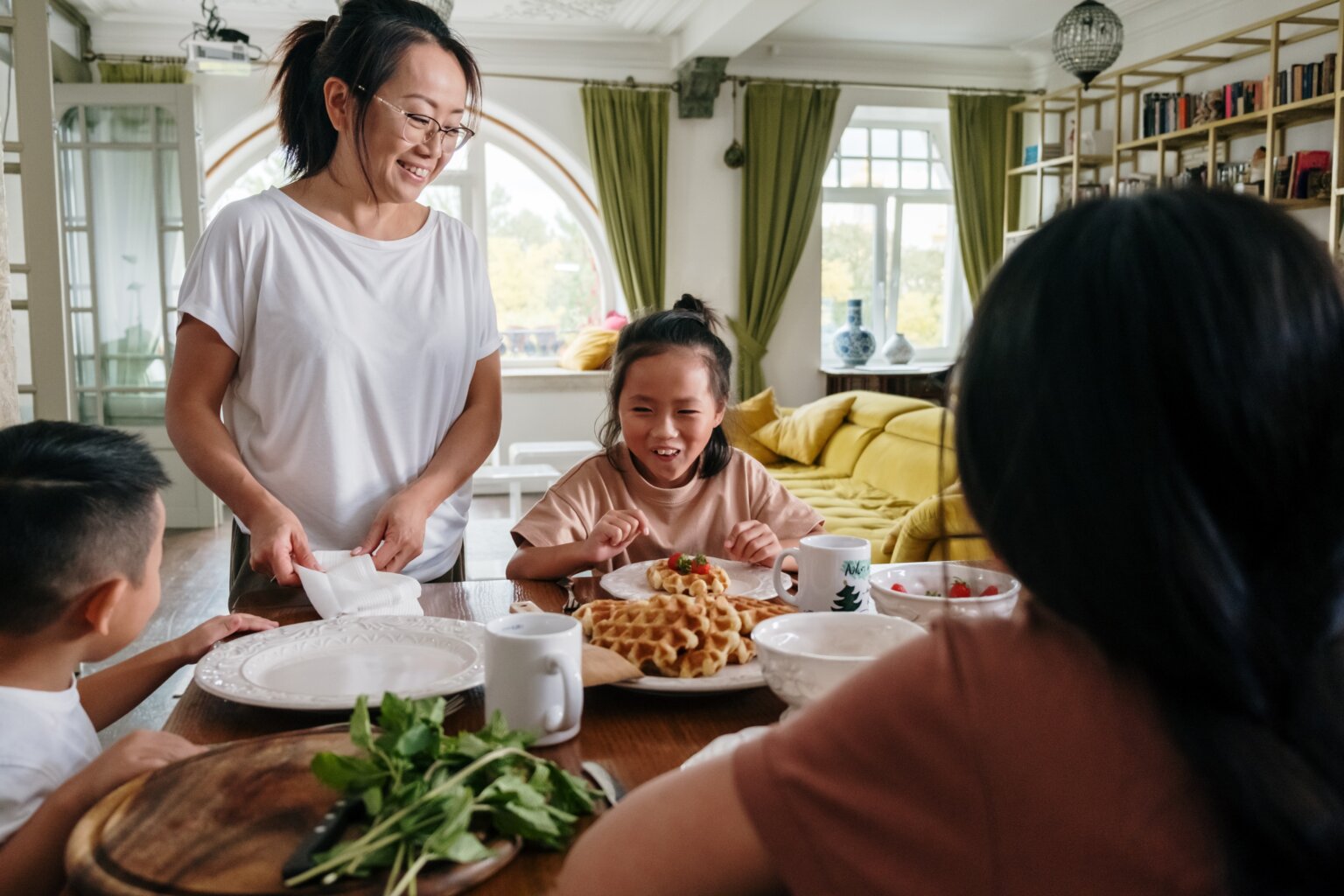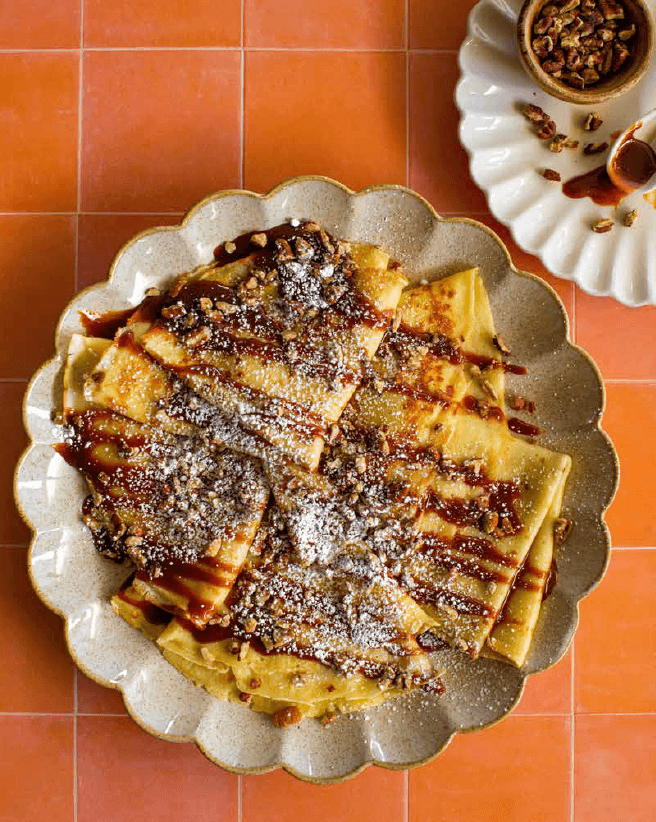
Starting Conversations about Culture with Food
Everyone has to eat and loves eating (unless you’re a robot), so starting conversations with food is the best way to bridge the gap between cultures. Here’s how.
- The Significance of Food in Culture
- The Benefits of Sharing Culture Through Food
- Conversation Starters
- A Recipe to Start Conversations
- Explore New Cuisines
- Books to Start Cultural Conversations
Does your family have that one recipe that’s practically sacred? It was passed from your great-grandma to your grandma to your mother and now to you, and you’ve been given strict guidance on the right way to make it. And you think that if you do something wrong, your mom will appear over your shoulder to nag at you even though she’s halfway across the continent.
If you have one of these recipes, it’s probably a food that you make for special occasions: a holiday, a celebration, a big gathering. It’s the kind of recipe that can bridge generations and cultures. It’s the kind of recipe that you bring out to start conversations and make people smile.
Food can be one of the best ways to start conversations with other cultures, and here’s how.
The Significance of Food in Culture
In the past, cultures ate what they could grow in their regions and made meals they liked. With many diverse regions, the world developed a varied and flavorful palate. These foods have been passed down through families for generations, and the taste, sight, and smell of each food has become an integral part of our unique cultural identities and traditions.
You can learn all of this and so much more from what people eat. Americans eat hot dogs at baseball games. My family makes povitica, a Yugoslavian nut bread, throughout fall and winter. And many Hispanic families make tamales for Christmas. The conversation comes from asking, Why?
The Benefits of Sharing Culture through Food
Although we might not understand the many languages around the world, history has shown that food is social. Sharing our foods and traditions can be a bridge to understanding and appreciating diverse cultures.
Some of the other benefits of sharing our foods and traditions are
- starting conversations,
- breaking the ice,
- building relationships,
- connecting generations,
- preserving heritage, and
- promoting cultural awareness.
Conversation Starters
Starting conversations can be a challenge, especially if you’re visiting a new region or building relationships with new people. But food can make it easy to overcome cultural boundaries. Just remember to approach these cultural food conversations with respect and an open mind.
But if you don’t know where to begin, use these simple food-related conversation starters to expand your palate, your relationships, and your cultural understanding:
1. Cook Together
Suggest cooking a meal together with someone who is from another culture. This can be a fun way to bond and learn about each other’s heritage. Say, “Would you be interested in cooking a traditional [cuisine] dish together sometime?”
2. Compliment a Dish
Begin by complimenting the meal or dish. For example, “This looks delicious! What inspired you to make it?” Or if you’ve recently tried a cultural dish or attended an event with ethnic cuisine, you can say something like, “I tried [dish name] from [cuisine] recently, and it was amazing. Have you ever had it?”
3. Ask about Heritage
If you know someone’s cultural background, show interest in their heritage by asking about traditional foods. For example, “I know you have [heritage], can you tell me about some traditional dishes from your culture?”
4. Share Experiences
Share your experiences of trying a new cultural dish or cuisine. You can say, “I recently visited a [cuisine] restaurant, and I tried [dish]. It was such a unique flavor! Have you ever tried it?”
5. Ask for Recommendations
If you’re curious about trying new foods, ask for recommendations from people who are familiar with a specific cuisine. You can say, “I’m looking to explore more [cuisine]. Do you have any must-try dishes or restaurant recommendations?”
6. Ask for Cooking Tips
If you’re interested in cooking cultural dishes at home, ask for cooking tips or recipe recommendations. For instance, “I’d love to try making [dish] at home. Do you have any tips or a favorite recipe?”
7. Discuss Etiquette and Traditions
Learn about the cultural etiquette and traditions associated with food. You can ask, “Are there any specific customs or traditions related to eating in your culture that you find interesting?”
8. Share Childhood Memories
Engage in a conversation about childhood food memories related to cultural dishes. Ask questions like, “What are some of your favorite dishes that your family used to make when you were a child?”
9. Discuss Food and Travel
If you or the other person enjoys traveling, discuss experiences of trying authentic dishes while traveling. Share stories or ask, “What’s the most memorable cultural food experience you’ve had during your travels?”
10. Ask about Cultural Food Events
Mention or inquire about cultural food events, such as food fairs, international food markets, or cultural food nights at local restaurants. You can say, “I heard there’s a [cuisine] food festival happening this weekend. Have you been before?”
11. Ask about Favorites
Start by asking someone about their favorite foods, cuisines, or dishes. You can say something like, “What’s your all-time favorite meal?” or “Do you have a go-to comfort food?”
12. Discuss Cultural Food Trends
Inquire about current food trends or food-related news. You can say, “Have you heard about the latest food trend?” or “What do you think about the rise of plant-based diets?”
13. Ask about Dietary Preferences
If you know the person’s dietary preferences or restrictions, you can ask about their favorite dishes within those parameters. For example, “What are your favorite vegan-friendly meals?”
14. Share Cooking Challenges
Share or ask about cooking challenges, such as attempting to make a difficult recipe or trying a food you’ve never had before. You can say, “I recently tried making homemade pasta for the first time. Have you ever taken on a cooking challenge?”
15. Discuss the Spice Level
Discuss the level of spiciness or seasonings in the food. You might ask, “Is this typically a mild or spicy dish in [cuisine]?”
16. Ask about Cultural Fusion
If the meal involves fusion cuisine, discuss the fusion elements and flavors. Ask, “What inspired the fusion of these two cuisines, and how does it enhance the flavors?”
17. Share Favorite Ingredients
Find out if there are specific ingredients or flavors that your dining companions particularly enjoy (or don’t enjoy). You can say, “Do you have a favorite ingredient that you love in [cuisine] dishes?”
18. Share Favorite Desserts
If you’re having dessert, ask about favorite desserts from the culture. Say, “I’m looking forward to dessert. What are some popular desserts in [cuisine]?”
A Recipe to Start Conversations
One of my favorite conversation-starting recipes is Crepas con Cajeta y Nuez from Ericka Sanchez and Nicole Presley’s Mexican breakfast cookbook, ¡Buenos Días! Infused with the traditions of Mexico and America, this recipe is sure to bridge cultures and relationships with its delicious flavors.
Check out the other amazing recipes in this cookbook for more conversation inspiration.
Crepas con Cajeta y Nuez
Crepes with Cajeta and Pecans
Sweet and savory crepes were regularly served for breakfast in my home growing up. They are made quickly in a blender and call for few and readily available ingredients. The toppings can vary, but our favorites are cajeta, pecans, and a sprinkle of confectioner’s sugar. This recipe can be modified into a savory version by omitting sugar and vanilla extract and topping with ingredients such as ham, cheese, and sautéed mushrooms. —Ericka Sanchez
Makes 8–10
Preparation time: 10 minutes
Resting time: 35 minutes
Cooking time: 20 minutes

Ingredients
- 1 cup all-purpose flour
- 2 eggs, room temperature
- 1 cup 2% milk
- 3 tablespoons butter, melted and cooled to room temperature
- 1 1/2 tablespoons granulated sugar
- 1 teaspoon vanilla extract
- 1/8 teaspoon salt
- 1/3 cup water
Toppings
- Goat milk caramel [see page 190] or dulce de leche
- Finely chopped pecans
- Confectioner’s sugar
Instructions
- Combine flour, eggs, milk, butter, sugar, vanilla, salt, and water in a blender. Blend until smooth.
- Refrigerate mixture for 35 minutes.
- Heat a 10-inch non-stick pan over medium heat. Spray with non-stick cooking spray or grease with butter.
- Scoop 1/3 batter onto pan and swirl, coating the bottom of the pan with an even layer. Cook for 40 to 45 seconds or until golden spots form. Flip the crepe and cook for 20 seconds.
- Transfer to a large plate and cover with aluminum foil loosely to keep warm.
- Repeat with remaining batter.
- To serve, fold each crepe in fourths.
- Place 2 to 3 crepes on a serving plate. Drizzle with cajeta, sprinkle with pecans, and dust with confectioner’s sugar.
Explore New Cuisines
The most important part of using food to start cultural conversations is to step out of your comfort zones and explore new cuisines. Whether it’s during celebrations like Hispanic Heritage Month or just during your everyday life, you will not only enjoy trying different flavors and dishes but also grow closer with the people in your community. Because everyone has to eat and loves eating (unless they’re a robot *squints suspiciously*), new ethnic food is the best conversation starter. You can build a stronger relationship with your friends and family by trying new recipes, asking about their food preferences, and sharing experiences.
Books to Start Cultural Conversations
Shaelyn Topolovec earned a BA in editing and publishing from BYU, worked on several online publications, and joined the Familius family. Shae is currently an editor and copywriter who lives in California’s Central Valley.
